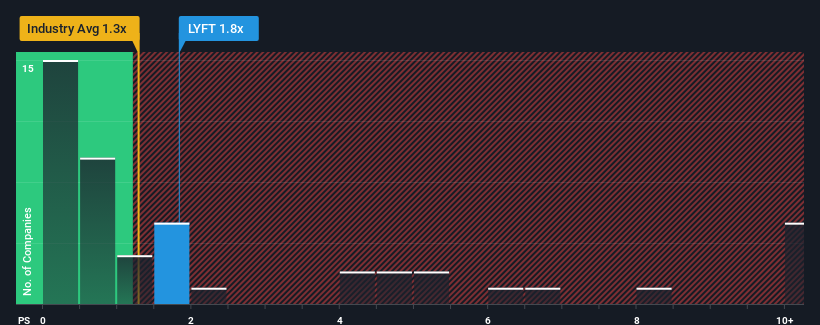- United States
- /
- Transportation
- /
- NasdaqGS:LYFT
Lyft, Inc.'s (NASDAQ:LYFT) P/S Is Still On The Mark Following 27% Share Price Bounce

The Lyft, Inc. (NASDAQ:LYFT) share price has done very well over the last month, posting an excellent gain of 27%. The annual gain comes to 104% following the latest surge, making investors sit up and take notice.
Following the firm bounce in price, when almost half of the companies in the United States' Transportation industry have price-to-sales ratios (or "P/S") below 1.3x, you may consider Lyft as a stock probably not worth researching with its 1.8x P/S ratio. Although, it's not wise to just take the P/S at face value as there may be an explanation why it's as high as it is.
See our latest analysis for Lyft

How Has Lyft Performed Recently?
Lyft certainly has been doing a good job lately as it's been growing revenue more than most other companies. It seems the market expects this form will continue into the future, hence the elevated P/S ratio. You'd really hope so, otherwise you're paying a pretty hefty price for no particular reason.
Keen to find out how analysts think Lyft's future stacks up against the industry? In that case, our free report is a great place to start.What Are Revenue Growth Metrics Telling Us About The High P/S?
The only time you'd be truly comfortable seeing a P/S as high as Lyft's is when the company's growth is on track to outshine the industry.
If we review the last year of revenue growth, the company posted a worthy increase of 7.5%. The latest three year period has also seen an excellent 86% overall rise in revenue, aided somewhat by its short-term performance. So we can start by confirming that the company has done a great job of growing revenues over that time.
Shifting to the future, estimates from the analysts covering the company suggest revenue should grow by 13% per year over the next three years. Meanwhile, the rest of the industry is forecast to only expand by 8.9% each year, which is noticeably less attractive.
In light of this, it's understandable that Lyft's P/S sits above the majority of other companies. It seems most investors are expecting this strong future growth and are willing to pay more for the stock.
What Does Lyft's P/S Mean For Investors?
The large bounce in Lyft's shares has lifted the company's P/S handsomely. We'd say the price-to-sales ratio's power isn't primarily as a valuation instrument but rather to gauge current investor sentiment and future expectations.
We've established that Lyft maintains its high P/S on the strength of its forecasted revenue growth being higher than the the rest of the Transportation industry, as expected. At this stage investors feel the potential for a deterioration in revenues is quite remote, justifying the elevated P/S ratio. Unless these conditions change, they will continue to provide strong support to the share price.
It's always necessary to consider the ever-present spectre of investment risk. We've identified 3 warning signs with Lyft, and understanding them should be part of your investment process.
If companies with solid past earnings growth is up your alley, you may wish to see this free collection of other companies with strong earnings growth and low P/E ratios.
New: AI Stock Screener & Alerts
Our new AI Stock Screener scans the market every day to uncover opportunities.
• Dividend Powerhouses (3%+ Yield)
• Undervalued Small Caps with Insider Buying
• High growth Tech and AI Companies
Or build your own from over 50 metrics.
Have feedback on this article? Concerned about the content? Get in touch with us directly. Alternatively, email editorial-team (at) simplywallst.com.
This article by Simply Wall St is general in nature. We provide commentary based on historical data and analyst forecasts only using an unbiased methodology and our articles are not intended to be financial advice. It does not constitute a recommendation to buy or sell any stock, and does not take account of your objectives, or your financial situation. We aim to bring you long-term focused analysis driven by fundamental data. Note that our analysis may not factor in the latest price-sensitive company announcements or qualitative material. Simply Wall St has no position in any stocks mentioned.
About NasdaqGS:LYFT
Lyft
Operates a peer-to-peer marketplace for on-demand ridesharing in the United States and Canada.
Very undervalued with reasonable growth potential.
Similar Companies
Market Insights
Community Narratives



